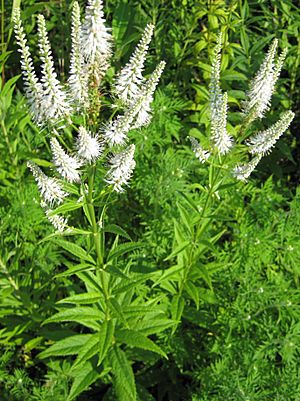Culver's root facts for kids
Quick facts for kids Culver's root |
|
|---|---|
 |
|
| Scientific classification | |
| Genus: |
Veronicastrum
|
| Species: |
virginicum
|
| Synonyms | |
|
|
Culver's root, also known by its scientific name Veronicastrum virginicum, is a beautiful flowering plant. It belongs to the plantain family. This plant grows naturally in the eastern United States and southeastern Canada. It can grow quite tall, up to about 200 centimeters (6.5 feet)! It's a perennial plant, meaning it lives for more than two years. In summer, it shows off its long, slender clusters of white, pink, or purple flowers.
Contents
What's in a Name?
Culver's root has a few other interesting names. Some people call it Culver's-root, Culverphysic, Bowman's root, or black root.
Why "Culver's Root"?
The most common name, "Culver's root," comes from a doctor named Dr. Culver. He was a doctor in the 1700s. He used the plant's bitter roots to help people with certain health issues.
Meaning of virginicum
The second part of its scientific name, virginicum, is Latin. It means "of Virginia." This name was given when "Virginia" referred to a much larger area. This area covered most of the eastern USA and southeastern Canada. This is roughly where the plant grows today.
What Does Culver's Root Look Like?
Culver's root is an herbaceous plant. This means it has soft, green stems, not woody ones like a tree.
Stems and Leaves
Its stems are smooth and usually grow straight up without branching. The leaves are arranged in circles around the stem. You'll find about 3 to 7 leaves in each circle. The edges of the leaves are serrated, which means they have small, saw-like teeth.
Flowers
The flowers grow in tall, spike-like clusters called racemes. These clusters can be about 9 inches (23 cm) long. They often look like a fancy candelabra! The tiny flowers are usually white, but sometimes they can be pink or purple. They are only about 2 millimeters long. The stamens, which are part of the flower, stick out like a little brush. Culver's root flowers for about a month. This usually happens from mid-June to late August, depending on where it grows.
Where Does Culver's Root Grow?
You can find Culver's root in many places across North America.
Natural Habitat
It grows from southern Maine all the way down to northwest Florida. You can also find it west to northern Louisiana and north through Minnesota. It even grows a bit north of the Canada–US border. This plant likes places that are wet or somewhat wet. It often grows in prairies and sometimes in moist, higher ground. You might also see it in areas where people are restoring native meadows or prairies.
Growing Culver's Root in Your Garden
Many people like to grow Culver's root in their gardens. It's a popular choice for gardens in the eastern and central United States.
Easy to Grow
This plant is quite easy to grow and can adapt to different conditions. Many plant nurseries sell it. It's becoming more common in gardens. It can handle cold weather, even down to -20°C (-4°F). It grows well in full sun or partial shade. It also likes moist, well-drained soil.
Care and Maintenance
If your Culver's root plant gets too big, you can easily dig it up. Then you can divide it into smaller pieces and replant them. It grows in an upright clump and doesn't spread out too much. Older plants might sometimes need a stake to keep them standing tall. You can also trim it down in late May if you want. This plant can also spread a bit by dropping its tiny seeds.
Award-Winning Plant
In the United Kingdom, there's a special type of Culver's root called 'Lavendelturm'. It has beautiful lilac-colored flowers. This type has even won an award called the Royal Horticultural Society's Award of Garden Merit!
Who Eats Culver's Root?
Culver's root is an important plant for some insects. The larvae (young caterpillars) of the Culver's root borer moth love to feed on this plant.

